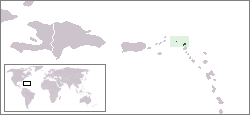 W
WThis is a list of amphibians and reptiles found in the British overseas territory of Anguilla, located in the Lesser Antilles chain in the Caribbean. It comprises the main island of Anguilla, and many much smaller islands and cays that have no permanent human population.
 W
WThis is a list of amphibians and reptiles found on Dominica, a Caribbean island-nation in the Lesser Antilles. Dominica is one of the few islands in that chain that has retained its original amphibian and reptile fauna over the last 200 years, and reptiles in particular form a significant part of its fauna.
 W
WThis is a list of amphibians and reptiles found on Grenada, an island in the Caribbean Lesser Antilles.
 W
WThis is a list of amphibians and reptiles found on the island of Martinique, an overseas department of France located in the Caribbean Lesser Antilles.
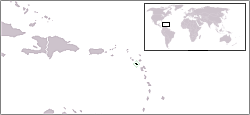 W
WThis is a list of amphibians and reptiles found in the British overseas territory of Montserrat, located in the Caribbean Lesser Antilles. The continuing eruptions of the Soufrière Hills volcano have devastated much of the island.
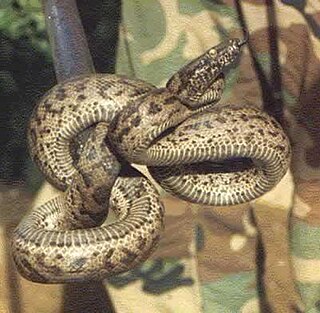 W
WThis is a list of the reptiles of the archipelago of Puerto Rico. The Puerto Rican archipelago consists of the main island of Puerto Rico, two island municipalities, Vieques and Culebra, one minor uninhabited island, Mona and several smaller islands and cays.
This is a list of amphibians and reptiles found on the island of Saint Barthélemy, located in the Lesser Antilles chain in the Caribbean. It is taken from the last updated list of the fauna of Saint Barthélemy.
 W
WThis is a list of amphibians and reptiles found on the islands of Saint Kitts and Nevis, a two-island nation in the Caribbean Lesser Antilles. The islands are separated by a narrow strait that is only 3.2 km wide and 15 m deep, and thus the two islands have very similar faunas.
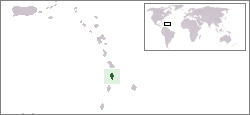 W
WThis is a list of amphibians and reptiles found on the island-nation of Saint Lucia, located in the Caribbean Lesser Antilles.
This is a list of amphibians and reptiles found on the island of Saint Martin, located in the Lesser Antilles chain in the Caribbean. Politically, Saint Martin is divided between the Collectivity of Saint Martin on the northern half of the island, which is an overseas collectivity of France, and Sint Maarten on the southern half, which is part of the Netherlands Antilles.
 W
WAmeiva ameiva, also known as the giant ameiva, green ameiva, South American ground lizard, or Amazon racerunner, is a species of lizard in the family Teiidae found in Central and South America and some Caribbean Islands.
 W
WThe American crocodile is a species of crocodilian found in the Neotropics. It is the most widespread of the four extant species of crocodiles from the Americas, with populations present from South Florida and the coasts of Mexico to as far south as Peru and Venezuela.
 W
WThe brown anole, also known commonly as the Bahaman anole or De la Sagra's anole, is a species of lizard in the family Dactyloidae. The species is native to Cuba and the Bahamas. It has been widely introduced elsewhere, by being sold as a pet lizard, and is now found in Florida and as far north in the United States as southern Georgia, Texas, Louisiana, Mississippi, Alabama, Hawaii, and Southern California. It has also been introduced to other Caribbean islands and Taiwan in Asia.
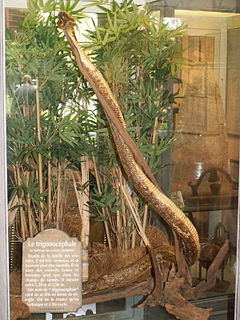 W
WBothrops lanceolatus — known as the fer-de-lance, Martinican pit viper, and Martinique lancehead — is a species of pit viper generally considered endemic to the island of Martinique. No one has satisfactorily explained why it has flourished there but is unknown on nearly all other Caribbean islands. Some reserve the common name fer-de-lance for this species, while others apply that name to other Bothrops species as well. No subspecies are currently recognized.
 W
WCnemidophorus arubensis, the Aruba whiptail, is a species of whiptail lizard in the genus Cnemidophorus. It is found on the island of Aruba.
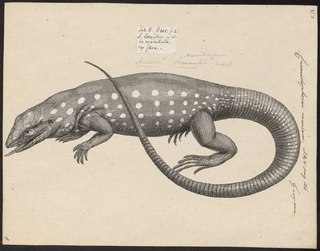 W
WCnemidophorus murinus, known commonly as Laurent's whiptail, is a species of lizard in the family Teiidae (whiptails). The species is endemic to Curacao, and is oviparous.
 W
WCnemidophorus ruthveni is a species of teiid lizard endemic to Bonaire and commonly known as the Bonaire whiptail. It was formerly considered a subspecies of Cnemidophorus murinus, commonly known as Laurent's whiptail, but that name is now restricted to the form found on the island of Curacao.
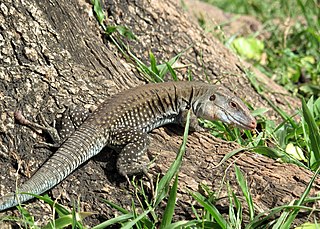 W
WThe common Puerto Rican ameiva or Puerto Rican ground lizard is a species of lizard in the whiptail family.
 W
WMorelet's crocodile (Crocodylus moreletii), also known as the Mexican crocodile, is a modest-sized crocodilian found only in fresh waters of the Atlantic regions of Mexico, Belize and Guatemala. It usually grows to about 3 metres (9.8 ft) in length. It is a Least Concern species. The species has a fossil record in Guatemala.
 W
WThe American crocodile is a species of crocodilian found in the Neotropics. It is the most widespread of the four extant species of crocodiles from the Americas, with populations present from South Florida and the coasts of Mexico to as far south as Peru and Venezuela.
 W
WCyclura is a genus of lizards in the family Iguanidae. Member species of this genus are commonly known as "cycluras" or more commonly as rock iguanas and only occur on islands in the West Indies. Rock iguanas have a high degree of endemism, with in most cases a single species or subspecies restricted to an individual island.
 W
WThe green anaconda, also known as giant anaconda, common anaconda, common water boa or sucuri, is a boa species found in South America. It is the heaviest and one of the longest known extant snake species. Like all boas, it is a non-venomous constrictor. The term "anaconda" often refers to this species, though the term could also apply to other members of the genus Eunectes.
 W
WThe Leeward Island racer is a species of snake in the family Colubridae. The species is found in Anguilla, Saint Barthélemy, and probably extinct on Sint Maarten.
 W
WMorelet's crocodile (Crocodylus moreletii), also known as the Mexican crocodile, is a modest-sized crocodilian found only in fresh waters of the Atlantic regions of Mexico, Belize and Guatemala. It usually grows to about 3 metres (9.8 ft) in length. It is a Least Concern species. The species has a fossil record in Guatemala.
 W
WPholidoscelis plei, known commonly as the Anguilla Bank ameiva or the Caribbean ameiva, is a species of lizard in the family Teiidae. The species is found on the Caribbean islands of Anguilla, Saint Martin, and Saint Barthélemy in the Lesser Antilles. Its coloration and markings vary between each island population. Two subspecies are recognized as being valid, including the nominotypical subspecies.
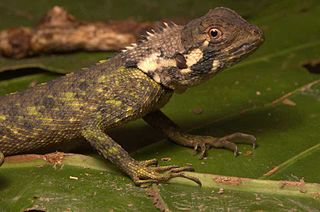 W
WPlica is a genus of tropidurid lizards endemic to South America and the Caribbean. Species in the genus Plica are arboreal, medium-sized lizards.
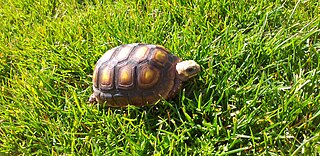 W
WThe red-footed tortoise is a species of tortoise from northern South America. These medium-sized tortoises generally average 30 cm (12 in) as adults, but can reach over 40 cm (16 in). They have dark-colored, loaf-shaped carapaces with a lighter patch in the middle of each scute, and dark limbs with brightly colored scales that range from pale yellow to dark red. Recognized differences are seen between red-footed tortoises from different regions. They are closely related to the yellow-footed tortoise from the Amazon Basin. They are popularly kept as pets, and over-collection has caused them to be vulnerable to extinction.
 W
WThe Saban black iguana is a species or subspecies of iguana thought to be endemic to the islands of Saba and Montserrat, although external evidence indicates that it may be distributed in other parts of the Caribbean. It was described in 2020.
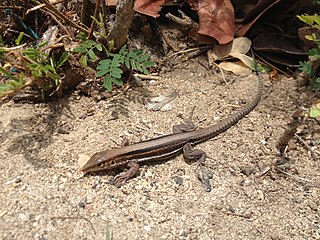 W
WThe Saint Croix ground lizard is a member of the Teiidae family of lizards.
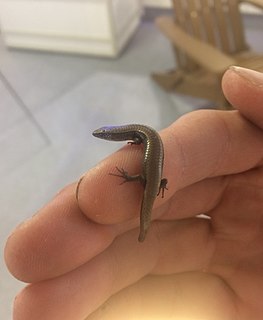 W
WThe Anguilla Bank skink (Spondylurus powelli) was discovered in the Caribbean with 20 other reptile species and was immediately listed as an endangered species. The population of this lizard has been decreasing due to the introduction of the mongoose, which was originally imported to control rats in sugarcane fields, and now is an invasive species to the Caribbean Islands. Many of the newly added skink species discovered along with S. powelli are facing extinction for the same reason. Skinks are unique and perhaps at a disadvantage among lizards as they produce a human-like placenta and have live birth. The average gestation period is suggested at one year and may be the cause for the skinks being an easy target to the mongoose, since they are larger and slower when pregnant. Other types of human activity, along with the deforestation in the Caribbean, are thought to have decreased overall species numbers, as well.
 W
WThe Terre-de-Haut racer is a species of snake found in the Caribbean, on the Lesser Antilles. This species is endemic to Terre-de-Bas Island and Terre-de-Haut Island which make up the Îles des Saintes. Terre-de-Bas and Terre-de-Haut are very small islands with a total area of approximately 13 km2. Because of its presence only on this small area, it is a highly protected species.
 W
WThe Gulf Coast box turtle is the largest subspecies of the common box turtle.
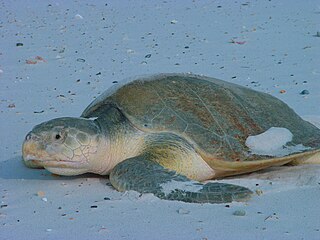 W
WKemp's ridley sea turtle, also called the Atlantic ridley sea turtle, is the rarest species of sea turtle and is critically endangered. It is one of two living species in the genus Lepidochelys.
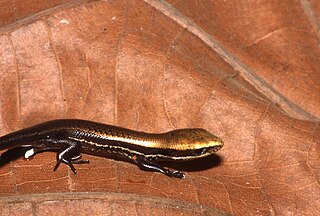 W
WVarzea bistriata is a species of skink found in South America and some islands in the Caribbean. The common name is the two-striped mabuya. It has shiny bronze or copper skin, with a dark longitudinal stripe along each flank that is often bordered by cream-colored lines.